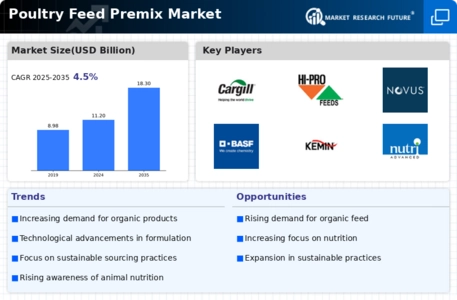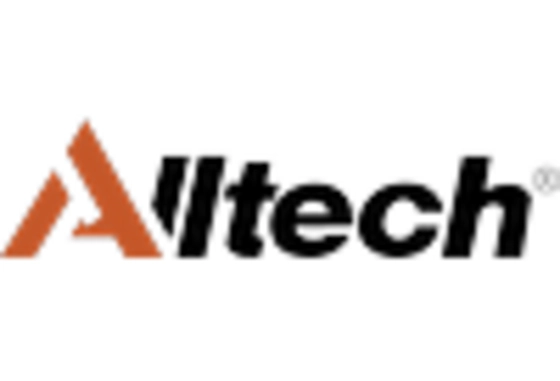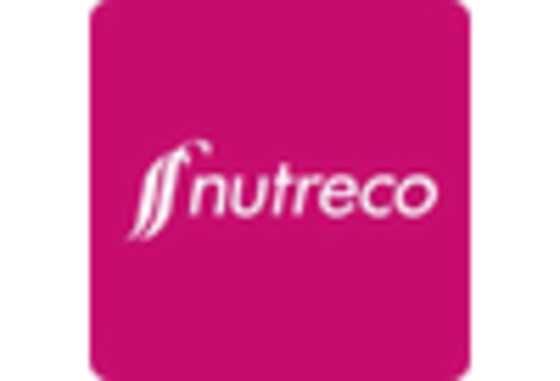Rising Demand for Poultry Products
The increasing The Poultry Feed Premix Industry. As populations grow and dietary preferences shift towards protein-rich foods, poultry remains a favored choice due to its affordability and versatility. According to recent data, poultry consumption is projected to rise by approximately 3% annually, leading to heightened production needs. This surge in demand necessitates the use of high-quality feed premixes to ensure optimal growth and health of poultry. Consequently, feed manufacturers are focusing on developing specialized premixes that cater to the nutritional requirements of various poultry species. This trend not only supports the growth of the Poultry Feed Premix Market but also encourages innovation in feed formulation to meet evolving consumer preferences.
Regulatory Support for Animal Nutrition
Regulatory frameworks that promote animal nutrition are playing a crucial role in shaping the Poultry Feed Premix Market. Governments and regulatory bodies are increasingly recognizing the importance of high-quality feed in ensuring food safety and animal welfare. Initiatives aimed at enhancing feed quality standards and nutritional guidelines are encouraging producers to adopt better practices in feed formulation. For example, regulations that limit the use of certain additives and promote the use of natural ingredients are pushing the industry towards more sustainable practices. This regulatory support not only enhances the quality of poultry products but also drives demand for specialized feed premixes that comply with these standards. As a result, the Poultry Feed Premix Market is likely to experience growth as producers seek to align their offerings with regulatory expectations.
Sustainability Initiatives in Feed Production
Sustainability initiatives are increasingly influencing the Poultry Feed Premix Market as producers seek to minimize their environmental impact. The poultry sector is under pressure to adopt practices that reduce carbon footprints and promote resource efficiency. This has led to a growing interest in feed premixes that utilize sustainable ingredients, such as by-products from other industries and locally sourced materials. Additionally, the implementation of sustainable production practices, such as reducing water usage and energy consumption, is becoming a priority for many feed manufacturers. As consumers become more environmentally conscious, the demand for sustainably produced poultry products is likely to rise, further driving the need for innovative and eco-friendly feed premixes. This shift towards sustainability not only benefits the environment but also positions the Poultry Feed Premix Market for long-term growth.
Technological Advancements in Feed Production
Technological innovations in feed production processes are significantly influencing the Poultry Feed Premix Market. The advent of precision nutrition and advanced feed formulation techniques allows for the creation of tailored premixes that enhance feed efficiency and animal health. For instance, the integration of data analytics and artificial intelligence in feed formulation enables producers to optimize nutrient profiles based on specific growth stages and health conditions of poultry. This level of customization is becoming increasingly important as producers aim to maximize yield while minimizing waste. Furthermore, the implementation of automated production systems is streamlining operations, reducing costs, and improving product consistency. As these technologies continue to evolve, they are likely to drive further growth in the Poultry Feed Premix Market, fostering a more sustainable and efficient poultry production landscape.
Focus on Health and Wellness in Poultry Production
The growing emphasis on health and wellness in poultry production is a significant driver of the Poultry Feed Premix Market. Consumers are increasingly concerned about the nutritional quality of poultry products, leading producers to prioritize the health of their flocks. This trend has prompted a shift towards feed premixes that incorporate functional ingredients, such as probiotics and prebiotics, which support gut health and overall well-being in poultry. Market data indicates that the demand for such health-oriented feed solutions is on the rise, as producers aim to enhance the quality of their products and meet consumer expectations. Consequently, the Poultry Feed Premix Market is witnessing an influx of innovative formulations designed to promote health and productivity in poultry, aligning with broader trends in food consumption.


















Leave a Comment